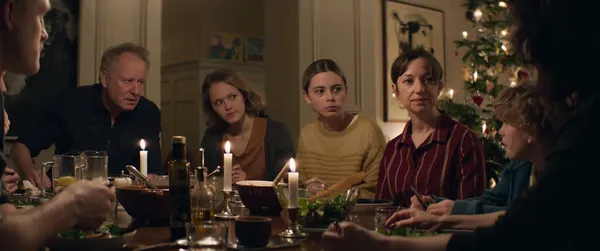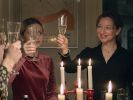Eye For Film >> Movies >> Hope (2019) Film Review
Hope
Reviewed by: Anne-Katrin Titze

The performances in Maria Sødahl’s stunning piece of auto-fiction (cinematography by Manuel Alberto Claro of Lars von Trier’s Melancholia, which stars Stellan Skarsgård with Kirsten Dunst, and Sødahl’s Limbo) are superb. Oscar-shortlisted Hope (Håp) hopes to become the sixth film from Norway (joining Arne Skouen’s Nine Lives; Nils Gaup’s Pathfinder; Berit Nesheim’s The Other Side of Sunday; Petter Næss’s Elling; Joachim Rønning and Espen Sandberg’s Kon-Tiki) to be nominated by the Academy of Motion Picture Arts and Sciences in what is now called Best International Feature Film. Nicole Kidman recently bought the rights for Hope to star in a series adaptation of the director’s story.
Anja (Andrea Bræin Hovig) returning home to Oslo from directing a successful stage production abroad, is greeted by her youngest child, 10-year-old Isak (Daniel Storm Forthun Sandbye), on the staircase of their building. He is wearing a pig mask. She lives with her partner Tomas (Stellan Skarsgård), their three children together, Julie (Elli Rhiannon Müller Osbourne), Simon (Steinar Klouman Hallert), and Isak, plus Henrik (Eirik Hallert), Ada (Dina Enoksen Elvehaug), and Erlend (Alfred Vatne), the three children he had with his ex-wife.

The big apartment looks like a gigantic mess upon her return. Anja’s absence resulted in a chaos of dirty dishes, toys and clothes strewn all over the place. Tomas clearly did not fulfill the commitment he made to her. Christmas is fast approaching, Anja’s father (Einar Økland) is visiting and she isn’t feeling very well with terrible headaches that almost blind her.
When the worst is confirmed, namely that the lung cancer she overcame the previous year may have spread to the brain, nothing in their world stays the same. Tomas, whose mind, we learn, had been mainly occupied with his work producing in the theatre, will have to make a choice to either fully support Anja or withdraw into the escape of the regions he seems to be so familiar with. Family friend Vera (Gjertrud L Jynge) enters the picture as a cautious sounding board and observer of a family that is going through a crisis that they all thought had been put safely into the past.
Instead of being based on a true story or inspired by actual events, the notation at the start of Hope states: “This is my story as I remember it.” These words make a much more personal claim and at the same time tell us that memory always includes the question of perspective.
Hope is structured around seemingly small jolts that suddenly illuminate the big picture. Little Isak early on admits that he spies on his family members because “how else can I find out what’s going on?” Secrecy is not always the best way to protect loved ones. In one of the most startling scenes, Skarsgård’s body is shaking as if revolting to the doctor’s words he doesn’t want to be true. A Belgian producer colleague and his 11-year-old daughter were initially invited by Tomas to join in the holiday celebration. What this triggers in various family members is as nuanced as it is profound.
The classic fairy-tale trope of the dying wife telling the husband that she wants him to marry only a woman as beautiful and smart as herself is anything but static in Anja’s head. The medication cocktail takes its toll. She eats from the gigantic tables of leftovers (one of the meds is prescribed to anorexics), and does her best not to lose her mind when so much still depends on her functioning for others.
As the story unfolds from pre-Christmas into the New Year, key moments shed light on the work it takes to truly be in a committed relationship. Stellan Skarsgård, the anchor of the film, is masterful at reacting. His “reactor” stays close to us in revelations and realizations, while we discover with him what Anja has been feeling and dreading for quite some time. Andrea Bræin Hovig merges sickness with strength, her furious vacuuming is as intense as the laughing fit inside the bridal boutique.
“I don’t advise you to read about the side effects,” suggests the pharmacist who hands Anja her medication. Can a death sentence have side effects? Hope may be an important one of them as Tomas struggles in his role as caregiver and confidant to Anja. While he searches helplessly to find the right formula in their meetings with doctors and health care providers, the divide that has existed in their relationship is revealed to us.
“We haven’t lived the same life,” says Anja when Tomas complains that her description of their history to a priest sounded “shabby.” Her jealousy of the professional opportunities casually afforded him enter in stark relief. The sound design, including boldly placed silences, does its part to make Hope an experience of the senses.
Reviewed on: 01 Mar 2021















